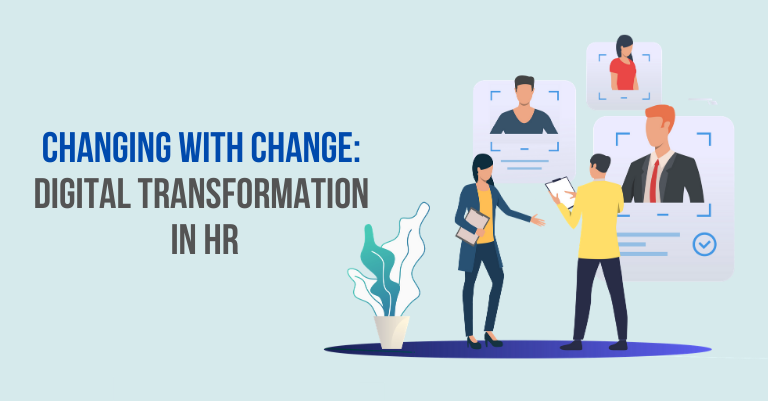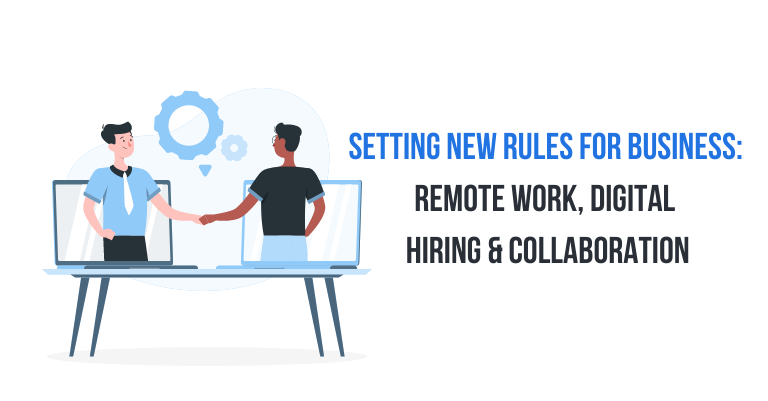
Changing With Change: Digital Transformation In HR
Posted On: April 1, 2020
Digital transformation is a process and a revolutionary change. But also it is an outcome and an evolutionary phenomenon. Digital transformation has changed the outlook on Human Resource Management. In the contemporary world, people apply for online jobs, go through digital interview processes, and even work remotely as well. As an HR manager, it’s pivotal to acknowledge that technology has become an integral part of today’s workforce management.
According to a report by Deloitte, digital transformation budgets are going to increase by 25 % by the year 2020. HR teams are moving from excel sheets to Artificial intelligence, Machine learning, blockchains, and automated performance management. Digital Transformation of HR services will improve the workflow of the organization and provide a transparent employee engagement. It empowers employees to make necessary decisions at the workplace or any organization tasks without any supervision. The organizations are providing AI and ML-powered tools/resources to employees in order to make a long-term digital HR strategy.
In a recent Gartner survey, two-thirds of business leaders said that if their company does not digitalize more by 2020, it will no longer be competitive.
In HR, digitalization is changing everything, from hiring to developing talent and raising performance.
How Can Technology Impact Human Resource Management?
Technology is becoming more and more essential to ensure the employees can do their work efficiently. Digital transformation in HR is a unique interplay between technology, people and process. To achieve successful business results, organizations are adopting the transformative effect of technology in the HR environment. It helps employees become more efficient, productive, and precise to make better decisions. In other words, it eliminates all boring, repetitive work through automation, using AI. Research shows that nearly 40 percent of companies are using some form of AI in HR. This strategy deploys machine intelligence to enable new opportunities and empower businesses, customers, and employees.
In recent years, technology has highly automated the typical functions of the HR department. For instance, payroll transmission, record keeping, training, skill management, job interviews, hiring, and compensations. These activities have been partly automated and managed in the Cloud, which has automated the basic processes of HR management. By introducing new functions making employees more involved and teams work together more efficiently. There is a strong need for organizations to adopt a platform that manages talents and teamwork transparently.
The overall introduction of digital elements for Hiring, on-boarding, employee surveys, performance reviews, payroll and everything else in between makes an organization more flexible and agile. A lot of energy and time will be saved, any document can be retrieved and reviewed in no time. Above all, it allows the HR department to document everything systematically, in particular complaints, information requests, and other reports. Most of the organizations are developing mobile applications for the Human Resource Management System and providing chatbots to provide a more seamless employee experience. The employees can get into the application for queries, complaints, etc irrespective of the time and place. Managers can also digitally approve/reject employee’s time-off requests, schedule shifts and create timesheets on which staff can track over time, manage company expenses and interactive reports.
From hiring for remote working projects to digital training and onboarding. Leveraging digitally advanced processes to free up HR personnel from repetitive work, will not only save time and resources but will also allow teams to expand and use their expertise in bringing in better talent to the business.
How Can Investing In Technology Improve Employee On-boarding?
Remote working is becoming a growing reality in almost every sector including customer service. Organizations are finding ways to cut down the workload for HR and making the hiring process more transparent. When you understand the causes of the problem, you can build targeted solutions. The walk-ins were time-consuming. The candidates from remote locations had to struggle to attend the interview sessions. It has always been a bottleneck for the HR department to manage. Digital Transformation in HR services has made it quite simple keeping organizations ahead in time.
Digital Hiring
The companies are coming up with tools and software to make the hiring process very easy for the candidates. Cloud-based hiring tools will allow recruiters and consultants to easily and affordably find, evaluate and organize top job candidates. Innovative assessment and filtering techniques will help to provide a 360-degree holistic view of top applicants.
For instance, at KocharTech, the Digital Hiring system asks applicants to record a video of themselves talking about their interests and motivation for the role. This video is uploaded with the required details for the online job application. After getting shortlisted the HR team interviews the candidate and even conducts required tests through a video call. The applicant ends up only visiting our premises once for a final face-to-face interview with their potential supervisor. Therefore, without any hassle, the hiring process will be completed.
Twenty years ago, the resume was a piece of paper but now, it’s a source for all candidate data. This data has been collected from online platforms, like participation in online communities, conferences, and meet-ups, and social media groups, company websites, etc. All are being stored in a cloud-based centralized repository of the organization. The HR team can assess whether a person will fit, and learn if he or she has the right skills for a job in need. Candidates are also aware of the job opportunities and make it easier for their potential HR managers to employ them by using online profiles, digital portfolios, and social media. It saves time, energy and reduces cost for the employer and the potential employee both.
Training
Organizations are reducing the workload by introducing a Learning Management System (LMS) or a Knowledge Management System (KMS) in the training process. The candidates are given access to an app where all the information related to the organization and processes is stored. They can simply access that information in the form of articles and get ready for training. The user experience can be moderated. Therefore, the candidates will see what that organization wants them to see. This secures data and ensures the correct skillset for the candidates. This helps the candidates to trigger their knowledge about the process by a systematic self-study while on board. As a result, it reduces the cost and time for the organization.
Not only does digital learning help in training, but it also compliments the digital transformation of HR processes, leaving HR personnel with more time to focus on important things. With tools like interactive decision trees or how-to guides, employees can figure their way out of simple HR queries and processes themselves.
The Future Of Human Resources
The human resource market has grown exceptionally today, thanks to the integration of technology. Forbes indicates that the global HR management sector is set to touch 30 billion by 2025. This is not surprising at all. The implementation of technology in the HR process has opened a whole new window for potential employees. The importance of the cloud in Human resource management is a growing reality. The possibility to manage work in a digital platform has not only closed the gap between employee and employer but also significantly increased earnings.
For instance, In Japan, many companies use mobile application platforms to manage temporary workers. The system has benefited organizations such as reduced cost, access to a large work database, specific skill requests and greater and easier collaboration.
Virtual reality (VR) and Augmented reality (AR) is transforming human resource management significantly. Nowadays companies are looking to experiment in the recruitment process. They are trying to do a little gamification of onboarding too. Soon, the candidates no longer only are asked how they would behave in a given situation. But they will be allowed to live it with virtual reality: at that point, it will be possible to evaluate their competences and their behaviors in a concrete situation. HR teams are already using VR for training purposes.
Driving Change
Digital transformation aims to create agile human resource management. The organization that is ready to adopt new methods of technology, will keep itself ahead of time. Besides, these methods contribute to the reduction of the organization’s risks and responsibilities. Employment laws are complicated, so taking appropriate measures by keeping updated digital records is very important to prevent any liabilities. A digitized Human Resource ecosystem enhances employee retention.



